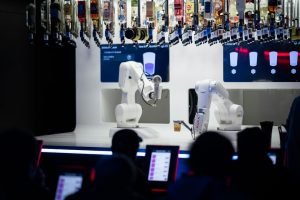China Launches First Retail Hub for Robotics
Discover China’s first retail hub for robotics, the ‘Robot Mall.’ Explore innovations and the future of retail tech. Learn more today!
Introduction to China’s Robot Mall
Overview of the Robot Mall
China has taken a significant leap into the future with the opening of its first-ever mall dedicated entirely to robots. This innovative establishment is designed to showcase the latest advancements in robotics technology, offering a unique shopping experience where robots are both the products and the service providers.
The mall aims to position China at the forefront of the global robotics industry by providing a platform for cutting-edge innovations and consumer interactions with robots.
Features and Offerings
The Robot Mall is a sprawling complex that features a wide array of robotic products and services. Visitors can explore different sections dedicated to various types of robots, including domestic helpers, industrial robots, and entertainment robots.
Each section is designed to provide an interactive experience, allowing customers to see demonstrations and even try out some of the robots themselves.
In addition to showcasing robots, the mall also features a variety of robotic services. From automated customer service kiosks to robotic guides that assist visitors in navigating the mall, the integration of robots into the mall’s operations is a testament to the versatility and potential of robotics technology.
Impact on the Robotics Industry
The opening of the Robot Mall is expected to have a significant impact on the robotics industry, both within China and globally.
By providing a centralized location for showcasing and selling robots, the mall offers robotics companies a unique opportunity to reach a wider audience. This can lead to increased sales, greater public awareness, and accelerated development of new technologies.
Furthermore, the mall serves as a hub for collaboration and innovation.
It brings together industry leaders, researchers, and consumers, fostering an environment where new ideas can be exchanged and developed. This collaborative atmosphere is likely to spur advancements in robotics technology, driving the industry forward.
Future Prospects
As the first of its kind, China’s Robot Mall sets a precedent for future developments in the retail and robotics sectors.
Its success could inspire similar ventures in other parts of the world, leading to a new era of shopping experiences centered around technology and automation. The mall not only highlights China’s commitment to technological advancement but also underscores the growing importance of robotics in everyday life.
Looking ahead, the Robot Mall is poised to become a major attraction, drawing visitors from around the globe who are eager to witness the future of retail and robotics firsthand.
Its continued evolution will likely play a crucial role in shaping the future of the robotics industry and its integration into society.
Cutting-Edge Technology on Display
Innovative Retail Experience
China’s groundbreaking ‘Robot Mall’ presents a revolutionary retail experience, where robots take center stage in both service and entertainment. This mall is a testament to China’s commitment to integrating advanced robotics into everyday life, offering visitors a unique glimpse into the future of shopping.
Robots in the mall are designed to enhance customer experience by providing personalized assistance, managing inventory, and even performing maintenance tasks.
This seamless integration of technology aims to streamline operations and create an engaging environment for shoppers.
Robotic Interactions
Visitors to the Robot Mall can interact with a variety of robots, each equipped with state-of-the-art artificial intelligence. These robots are capable of understanding and responding to customer inquiries, guiding them through the mall, and offering product recommendations based on individual preferences.
The interaction is not only functional but also entertaining, as some robots are programmed to perform shows and demonstrations, showcasing their agility and precision.
This blend of utility and entertainment highlights the versatility of modern robotics.
Advanced Automation
Behind the scenes, the Robot Mall employs cutting-edge automation technologies to ensure efficient operations. From automated checkout systems to robotic stocking and inventory management, these technologies reduce human error and increase efficiency.
The mall serves as a testing ground for future retail innovations, with developers continuously refining the technology to enhance performance and reliability.
This focus on automation underscores the potential for robots to revolutionize the retail industry.
Future Implications
The Robot Mall is more than just a novelty; it represents a significant shift towards a more technologically integrated society. By showcasing the capabilities of robots in a public setting, the mall encourages acceptance and adoption of robotics in daily life.
As technology continues to advance, the implications for employment, consumer behavior, and urban development are profound.
The Robot Mall serves as a catalyst for discussions on the future role of robots in society, highlighting both the opportunities and challenges that lie ahead.
Impact on Retail Industry
Revolutionizing Customer Experience
The opening of China’s first ‘Robot Mall’ marks a significant shift in how consumers interact with retail environments. By integrating advanced robotics, the mall offers a unique, futuristic shopping experience that attracts tech-savvy customers.
Robots assist in various tasks, from greeting customers to providing personalized recommendations based on real-time data analysis. This enhances the overall shopping experience, making it more efficient and enjoyable.
Operational Efficiency
Robots in the retail sector can perform repetitive tasks with precision and speed, reducing the need for human labor in certain areas.
This leads to increased operational efficiency as robots can manage inventory, restock shelves, and handle customer inquiries without fatigue. The automation of these processes allows human staff to focus on more complex customer service tasks, improving overall productivity.
Cost Implications
While the initial investment in robotics technology may be substantial, the long-term cost savings are significant.
Robots can operate continuously without breaks, reducing labor costs and minimizing human error. Additionally, the use of robots can lead to lower maintenance costs for the retail space as they can efficiently manage tasks that would otherwise require multiple employees.
Data-Driven Insights
The integration of robots in retail environments provides businesses with valuable data-driven insights.
Robots equipped with sensors and AI capabilities can track customer behavior, preferences, and purchasing patterns. This data can be analyzed to optimize product placement, tailor marketing strategies, and improve inventory management.
Retailers can use these insights to make informed decisions that enhance customer satisfaction and drive sales.
Challenges and Considerations
Despite the many benefits, the adoption of robots in retail also presents challenges. There are concerns about job displacement as robots take over tasks traditionally performed by humans.
Retailers must balance automation with human employment, ensuring that the workforce is upskilled to work alongside robotic systems. Additionally, the implementation of robotics technology requires significant investment in infrastructure and training, which may be a barrier for smaller retailers.
Future of Robotics in China
China Opens ‘Robot Mall’
China has taken a significant leap in the robotics industry by inaugurating its first-ever ‘Robot Mall.‘ This innovative space is dedicated exclusively to showcasing and selling robots, highlighting China’s commitment to becoming a global leader in robotics technology.
The mall serves as a platform for both consumers and businesses to explore the latest advancements in robotics, ranging from household robots to industrial automation solutions.
Driving Innovation and Economic Growth
The establishment of the Robot Mall is a testament to China’s strategic focus on integrating robotics into its economic framework. By fostering an environment that encourages technological innovation, China aims to enhance productivity across various sectors.
The robotics industry is expected to play a crucial role in driving economic growth, with projections indicating a significant increase in the adoption of robotics in manufacturing, healthcare, and service industries.
Government Support and Investment
The Chinese government has been instrumental in supporting the growth of the robotics industry. Through policies and investments, the government is creating a conducive ecosystem for research and development in robotics.
Initiatives such as tax incentives, grants, and subsidies are designed to attract both domestic and international companies to invest in China’s robotics sector. This support is crucial in maintaining China‘s competitive edge in the global market.
Challenges and Opportunities
While the future of robotics in China is promising, there are challenges that need to be addressed.
Issues such as workforce displacement, ethical considerations, and the need for skilled labor pose significant hurdles. However, these challenges also present opportunities for innovation in areas such as education and training programs, which can equip the workforce with the necessary skills to thrive in a robotics-driven economy.
Global Implications
China’s advancements in robotics have far-reaching implications on a global scale.
As China continues to lead in robotics innovation, it sets a benchmark for other countries to follow. This leadership not only influences global standards and practices but also encourages international collaboration in technology development.
The Robot Mall is a symbol of China’s ambition to shape the future of robotics and solidify its position as a global powerhouse in technology.
FAQ
Q1: What are the potential costs associated with adopting technology from the China Opens ‘Robot Mall’ for businesses?
A1: The costs of adopting technology from the China Opens ‘Robot Mall’ can vary significantly depending on the type and scale of the robotics solutions being implemented. Initial expenses may include the purchase price of the robots, which can range from affordable options for simple tasks to high-end models for complex operations. Additionally, businesses should consider the costs of installation, customization, and integration with existing systems. Maintenance and support services are ongoing costs that must be factored into the budget, as well as potential training programs for staff to effectively operate and manage the new technology. It’s crucial for businesses to conduct a thorough cost-benefit analysis to ensure that the investment aligns with their operational goals and financial capabilities.
Q2: How accessible is the technology from the Robot Mall for non-engineers or businesses without technical expertise?
A2: The Robot Mall is designed to cater to a wide range of users, including those without technical expertise. Many of the robots and solutions offered come with user-friendly interfaces and intuitive controls, making them accessible to non-engineers. Additionally, the mall provides comprehensive support services, including training programs and customer service, to assist businesses in adopting and utilizing the technology effectively. For businesses without in-house technical teams, partnering with third-party service providers or consultants can help bridge the gap, ensuring that the technology is implemented smoothly and efficiently. The goal is to make robotics technology more accessible and practical for businesses of all sizes and industries.
Q3: What are some implementation challenges businesses might face when integrating technology from the Robot Mall with existing tools and systems?
A3: Integrating new robotics technology from the Robot Mall with existing tools and systems can present several challenges. Compatibility issues may arise if the new technology does not seamlessly integrate with current software or hardware, requiring additional customization or middleware solutions. Businesses may also encounter resistance to change from employees, necessitating change management strategies and training programs to ensure a smooth transition. Furthermore, there may be logistical challenges, such as redesigning workflows or physical spaces to accommodate the new technology. To mitigate these challenges, businesses should conduct thorough planning and testing phases, engage with experienced integration partners, and maintain open communication with all stakeholders to address any issues promptly and effectively.
Takeaway
Ready to supercharge your productivity with cutting-edge AI technology? Try our AI tool today and revolutionize your workflow in minutes. Stay ahead of the curve by subscribing to our updates on the latest tech trends. Join our vibrant community of tech enthusiasts to share insights and engage in thought-provoking discussions. Level up your tech game now!











Comments